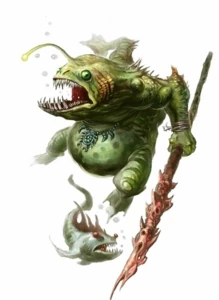m (Created page with '{{Creature | image = | name = Ceratioidi | type = Monstrous humanoid | subtype = Aquatic | challenge = 3 | environment = Any saltwater | alignment = …') |
No edit summary Tag: rte-source |
||
| (5 intermediate revisions by 2 users not shown) | |||
| Line 1: | Line 1: | ||
{{Creature |
{{Creature |
||
| − | | image = |
+ | | image = [[File:Ceratioidi.jpg|left]] |
| name = Ceratioidi |
| name = Ceratioidi |
||
| type = Monstrous humanoid |
| type = Monstrous humanoid |
||
| Line 10: | Line 10: | ||
| page = 80-81 |
| page = 80-81 |
||
}} |
}} |
||
| + | |||
| + | '''Ceratioidi''' are fish-like aquatic humanoids that inhabit bizarre, spired cities in the deep trenches of [[Golarion]]'s oceans. |
||
| + | |||
| + | Each ceratiodi is actually two creatures--a powerfully-built female, and a tiny parasitic male no bigger than a large rat. When joined, male and female retain their own independent consciousness, though the male's biological functions become linked to those of the female. A mated pair of ceratioidi share a powerful telepathic link, their unique mental structure allowing for them to excel in many fields of study, including combat and wizardry.<ref name="PF33-81">{{Cite book/Rivers Run Red|80|80-81}}</ref> |
||
| + | |||
| + | ==Appearance== |
||
| + | A typical female ceratioidi stands at about seven feet tall, and weighs around 300 pounds, with powerful limbs and a massive, toothed maw. In addition, a ceratioidi possesses a bioluminescent lure, known as an ''esca'', attached to their forehead by a fleshy appendage. This lure is the focus for their hypnotic abilities, and serves them both in the hunt and in combat.<ref name="PF33-81" /> |
||
| + | |||
| + | ==Society== |
||
| + | Little is known of ceratioidi society, save for the small [[River Kingdoms]] outpost known as [[Outsea]]. Long ago, in a military campaign against the [[merfolk]], a group of ceratioidi mercenaries were trapped in a patch of magically-contained brine deep inland on the [[Sellen River]]. Left with no choice but cooperation or death, the various aquatic races pooled their resources and created the community of Outsea, a town existing both above and below the waterline where terrestrial creatures trade with their aquatic neighbors.<ref name="PF33-81" /><ref name="GRK35">{{Cite book/Guide to the River Kingdoms|35}}</ref> |
||
{{stub}} |
{{stub}} |
||
| + | |||
| + | ==References== |
||
| + | {{refs}} |
||
[[Category:Monstrous humanoids]] |
[[Category:Monstrous humanoids]] |
||
[[Category:CR 3 creatures]] |
[[Category:CR 3 creatures]] |
||
Latest revision as of 00:41, 7 June 2017
| Ceratioidi | |
|---|---|
| (Creature) | |
| Type | Monstrous humanoid (Aquatic) |
| CR | 3 |
| Environment | Any saltwater |
| Alignment | |
Source: Rivers Run Red, pg(s). 80-81 | |
Ceratioidi are fish-like aquatic humanoids that inhabit bizarre, spired cities in the deep trenches of Golarion's oceans.
Each ceratiodi is actually two creatures--a powerfully-built female, and a tiny parasitic male no bigger than a large rat. When joined, male and female retain their own independent consciousness, though the male's biological functions become linked to those of the female. A mated pair of ceratioidi share a powerful telepathic link, their unique mental structure allowing for them to excel in many fields of study, including combat and wizardry.[1]
Appearance[]
A typical female ceratioidi stands at about seven feet tall, and weighs around 300 pounds, with powerful limbs and a massive, toothed maw. In addition, a ceratioidi possesses a bioluminescent lure, known as an esca, attached to their forehead by a fleshy appendage. This lure is the focus for their hypnotic abilities, and serves them both in the hunt and in combat.[1]
Society[]
Little is known of ceratioidi society, save for the small River Kingdoms outpost known as Outsea. Long ago, in a military campaign against the merfolk, a group of ceratioidi mercenaries were trapped in a patch of magically-contained brine deep inland on the Sellen River. Left with no choice but cooperation or death, the various aquatic races pooled their resources and created the community of Outsea, a town existing both above and below the waterline where terrestrial creatures trade with their aquatic neighbors.[1][2]
| This page is a stub. You can help us by expanding it. |
References[]
- ↑ 1.0 1.1 1.2 Adam Daigle, Ed Greenwood, Rob McCreary, Sean K Reynolds, and James L. Sutter. (2010). Bestiary. Rivers Run Red, p. 80-81. Paizo Publishing, LLC. ISBN 978-1-60125-233-3
- ↑ Elaine Cunningham, Steve Kenson, China Miéville, and Chris Pramas. (2010). Guide to the River Kingdoms, p. 35. Paizo Publishing, LLC. ISBN 978-1-60125-203-6

